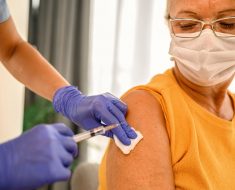The ongoing outbreak of the novel coronavirus disease 2019 (COVID-19) caused by the severe acute respiratory syndrome coronavirus 2 (SARS-CoV-2) infection poses a severe threat to humanity.
To date, it has caused over 146.8 million infections and 3.1 million confirmed deaths. Similarly, in the last two decades, two other highly pathogenic coronaviruses (CoVs) – SARS-CoV and Middle East respiratory syndrome CoV (MERS-CoV) – have caused severe epidemics.
The life cycle of the CoVs shows that the spike protein on its surface binds to the host cell’s angiotensin-converting 2 (ACE2) receptor via the virus receptor-binding domain (RBD) present on the viral spike protein. Because the RBD and ACE2 interaction is an integral process in the CoVs’ infection of the host cell, it is an attractive target for therapeutic drug development.
To develop therapeutics that block this binding process, a team of researchers recently used an integrated computational approach to design nanobodies (Nbs) against the SARS-CoV-2 RBD, using neutralizing/monoclonal antibodies specific to RBD of the spike protein. They suggested from this study that eleven of the (re)designed Nbs may bind the SARS-CoV-2 RBD and potentially neutralize the virus. The team recently released their findings in the journal Chemical Biology and Drug Design.
.jpg)
They achieved an Nb design by grafting the complementarity-determining regions (CDRs) of developed SARS-CoV, MERS-CoVs specific neutralizing antibodies (nAbs), including monoclonal antibodies (mAbs), as well as SARS-CoV-2 monoclonal antibodies (mAbs), onto a known stable nanobody (Nb) scaffold.
Nanobodies (Nbs) are single-domain antibodies (sdAbs) derived from camelids and sharks; they show a large sequence identity with the human VH gene family III. Because of the small size (~15 kDa) of the Nbs, thermostability, high binding specificity and low immunogenicity, Nbs are popular for many biotechnology and medical applications.
In the paper, the researchers elaborated on how the nanobody maturation technology is deployed to develop several Nbs targeting SARS-CoV-2 spike protein. Based on previous studies, it is assuring to suggest that Nbs may serve as useful and effective therapeutics during CoVs outbreaks.
Using the per-residue binding free energy decomposition analysis, they identified hotspots between the Nbs and the RBD. The usefulness of this information is demonstrated with this example: residue Y449 of RBD is important for CS03_Nbs-RBD bound complex, and mutations R45P, T59Q and S110Y of CS03 can be beneficial for the binding of CS03_Nbs and RBD.
The identified ‘hot spots’ on the interface of each complex provide useful information to understand the binding mechanism of designed Nbs to SARS-CoV-2 RBD.”
Using their design, the researchers developed 16 Nbs (CS01-CS16) by grafting the CDRs sequence of CoVs’ nAbs or mAbs into a known stable nanobody scaffold. To design the Nbs targeting SARS-CoV-2 RBD, the researchers saved only the RBD of three CoVs in complex with the “single domain antibodies (sdAb)” (referred to as the heavy chain of the corresponding nAbs) for all of the 16 structures of the neutralizing antibodies.
The researchers explained, “it is known that each sdAb (Nb) has a highly conserved framework with three complementarity determining regions (CDRs) of variable sequence composing the paratope.”
Out of the 16 Nbs, they found only 5 Nbs (CS01, CS02, CS03, CS10 and CS16) successfully docked onto the SARS-CoV-2 RBD with a different binding mechanism.
The model for designed Nb was selected by picking the structure with the best DOPE assessment score considering the Lennard–Jones potential and GBSA implicit solvent interaction.”
Among these, they reported that the CS01, CS02 and CS03 occupy the ACE2 binding site, while the CS10 and the CS16 bind to the near-ACE2 and non-ACE2 binding sites, respectively.
Using MD (Molecular Dynamics) simulation and binding free energy analysis, the researchers indicated that, except for CS02, the other four designed Nbs stably bind to the RBD of SARS-CoV-2.
Further to improve stability and binding affinities, the researchers redesigned the Nbs based on the structures of their complex with the RBD. Notably, the calculated binding free energy increased, from -39.13 kcal/mol (CS02-RBD) to 79.13 kcal/mol (CS02_RD01-RBD), especially for the redesigned CS02-RBD complex.
As a result of this study, the researchers showed 11 (re)designed Nbs (CS01, CS02_RD01, CS03, CS03_RD01, CS03_RD02, CS03_RD03, CS03_RD04, CS10, CS16, CS16_RD01, CS16_RD02) that exhibit stabilities and high binding affinities to SARS-CoV-2’s RBD.
Significantly, the “hot spots” between the Nbs and RBD interface and its analysis provide useful information to understand the binding mechanism of designed Nbs to SARS-CoV-2 RBD.
This study shows the potential of the developed computational framework to predict the stabilities and high binding affinities, to design the Nbs against SARS-CoV-2. The researchers presented here eleven (re)designed Nbs as effective agents to block the infection of SARS-CoV-2.
- Yang, J., Zhang, Z., Yang, F., Zhang, H., Wu, H., Zhu, F. and Xue, W. (2021), Computational Design and Modeling of Nanobodies toward SARS‐CoV‐2 Receptor Binding Domain. Chem Biol Drug Des. Accepted Author Manuscript. https://doi.org/10.1111/cbdd.13847, https://onlinelibrary.wiley.com/doi/10.1111/cbdd.13847
Posted in: Medical Science News | Medical Research News | Miscellaneous News | Disease/Infection News | Healthcare News
Tags: ACE2, Angiotensin, Antibodies, Biotechnology, Cell, Coronavirus, Coronavirus Disease COVID-19, Gene, MERS-CoV, Nanobodies, Protein, Receptor, Respiratory, SARS, SARS-CoV-2, Severe Acute Respiratory, Severe Acute Respiratory Syndrome, Spike Protein, Syndrome, Therapeutics, Virus

Written by
Dr. Ramya Dwivedi
Ramya has a Ph.D. in Biotechnology from the National Chemical Laboratories (CSIR-NCL), in Pune. Her work consisted of functionalizing nanoparticles with different molecules of biological interest, studying the reaction system and establishing useful applications.
Source: Read Full Article





